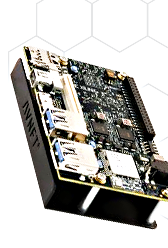

Technical Specification
Ultra96 is an Arm-based, Xilinx Zynq UltraScale+
MPSoC development board based on the Linaro 96Boards specification. The 96Boards’ specifications are open and define a standard board layout for development platforms that can be used by software application, hardware device, kernel, and other system software developers. Ultra96 represents a unique position in the 96Boards community with a wide range of potential peripherals and acceleration engines in the programmable logic that is not available from other offerings. Product Brief (Datasheet)
Ultra96 provides four user-controllable LEDs. Engineers may also interact with the board through the 96Boards-compatible low-speed and high-speed expansion connectors by adding peripheral accessories such as those included in Seeed Studio’s Grove Starter Kit for 96Boards.
Micron LPDDR4 memory provides 2 GB of RAM in a 512M x 32 configuration. Wireless options include 802.11b/g/n Wi-Fi and Bluetooth 4.2 (provides both Bluetooth Classic and Low Energy (BLE)). UARTs are accessible on a header as well as through the expansion connector. JTAG is available through a header (external USB-JTAG required). I2C is available through the expansion connector.
Ultra96 provides one upstream (device) and two downstream (host) USB 3.0 connections. A USB 2.0 downstream (host) interface is provided on the high speed expansion bus. Two Microchip USB3320 USB 2.0 ULPI Transceivers and one Microchip USB5744 4-Port SS/HS USB Controller Hub are specified.
The integrated power supply generates all on-board voltages from an external 12V supply (available as an accessory).
Click on the images to enlarge
Features
- Xilinx Zynq UltraScale+ MPSoC ZU3EG A484
- Micron 2 GB (512M x32) LPDDR4 Memory
- Delkin 16 GB microSD card + adapter
- PetaLinux environment available for download
- Microchip Wi-Fi / Bluetooth
- IDT VersaClock 6E clock generator
- Infineon high efficiency power management
- Aavid/Boyd Heatsink
- Mini DisplayPort (MiniDP or mDP)
- 1x USB 3.0 Type Micro-B upstream port
- 2x USB 3.0, 1x USB 2.0 Type A downstream ports
- 40-pin 96Boards Low-speed expansion header
- 60-pin 96Boards High-speed expansion header
- 85mm x 54mm form factor
- Linaro 96Boards Consumer Edition compatible
Target Applications
- Artificial Intelligence
- Machine Learning
- IoT/Cloud connectivity for add-on sensors
- Embedded Computing
- Robotic
- Entry level Zynq UltraScale+ MPSoC development environment
- Training, prototyping and proof-of-concept demo platform
- Wireless design and demonstrations using Wi-Fi and Bluetooth
Kit Includes
- Ultra96-V2 development board
- 16 GB microSD card + adapter
- Voucher for SDSoC License from Xilinx
- Quick-start instruction card
Reference Designs
Ultra96 Factory Image
SDSoC Baremetal Platform - Xilinx Matrix Multiply Example
SDSoC PetaLinux Platform - Xilinx Matrix Multiply Example
Development Using Ubuntu Desktop Linux
These tutorials provide a means to integrate several different technologies on a single platform. Using the Avnet target boards, we have the power of a ARM Cortex-A9 processors, combined with the unrivaled flexibility of Xilinx programmable logic to implement custom hardware systems. We use a Linux kernel as the foundation operating system running on the processor cores which enables a very large ecosystem of software to be run on our development kits. Virtual machines can provide a very convenient Ubuntu development environment for building the hardware platform and cross-compiling software to target the Processing System.
PetaLinux Board Support Packages
Vitis PetaLinux Platform
Vitis PetaLinux Platform PreBuilt Example
PYNQ Framework for Ultra96
Accelerate your designs with PYNQ, a Python friendly development framework for the ZYNQ SoC family. Available now for Ultra96.






